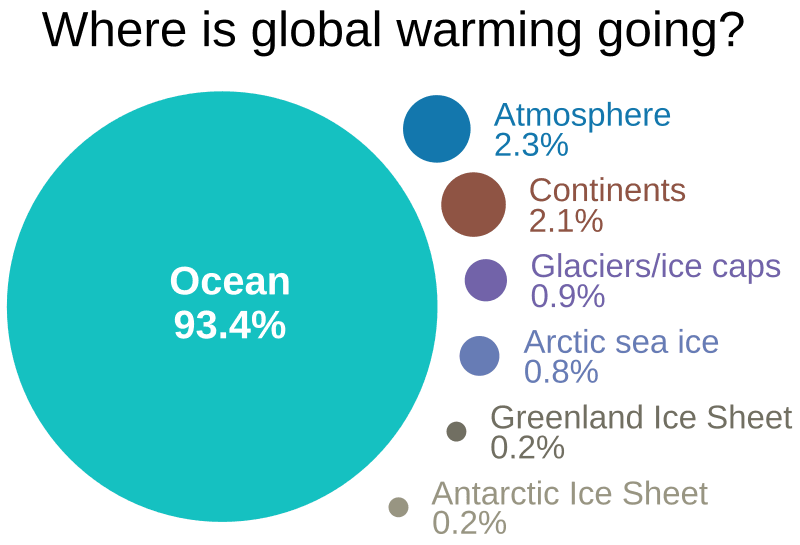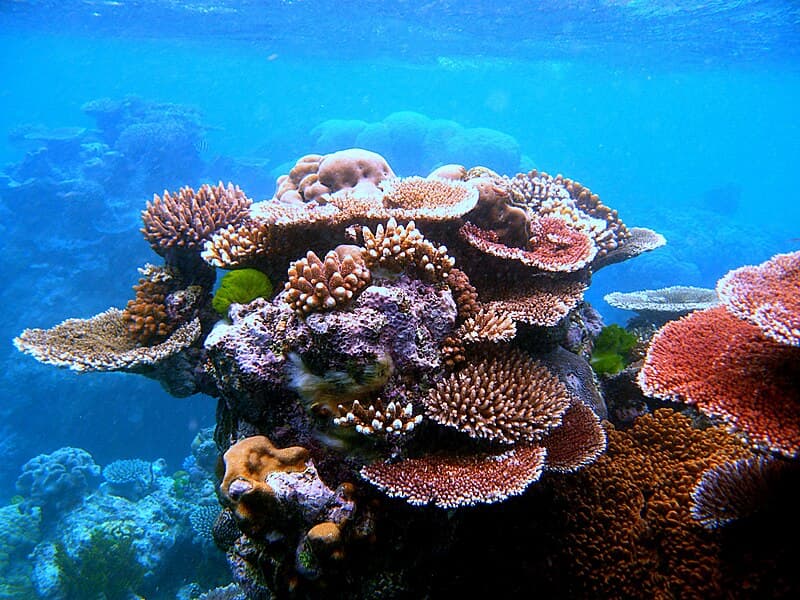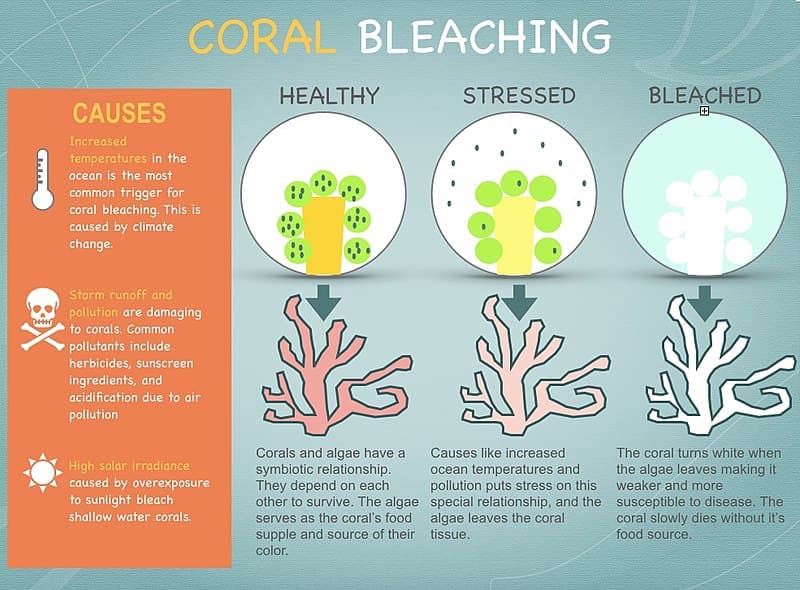Ocean Warming
Liam Thomas
6 min read
Listen to this study note
Study Guide Overview
This study guide covers the impact of climate change on oceans, focusing on the effects of rising temperatures. Key topics include the effects on ectotherms, the symbiotic relationship between coral and zooxanthellae, and the process of coral bleaching. The guide also discusses the melting of polar ice caps and its contribution to sea-level rise and albedo changes. Practice questions covering these concepts are included.
#Climate Change in the Oceans

#Image Courtesy of Wikimedia
As global air temperatures increase from excess greenhouse gasses, ocean temperature increases as well.
A lot of marine species are highly dependent on the temperature of the water to regulate the temperature of their bodies. Ectotherms, including fish, amphibians, reptiles, and invertebrates, depend on external sources of heat for their body temperature, meaning the body temperature of an aquatic ectotherm is usually very close to the temperature of the surrounding water. As the temperature of the ocean increases, organisms are subject to extreme metabolic stress and may lose the ability to metabolize their food or reproduce! 🐠
#Impact on Coral

#Image courtesy of Wikimedia
If the temperature becomes hotter than species can handle, they must be able to adapt or move. For sedentary (non-mobile) species like coral, the increase in temperature is often fatal.
Corals are complex animals made up of a colony of tiny polyps. Each polyp resembles a tiny sea anemone and catches small organisms. They also have a symbiotic relationship with algae called zooxanthellae.
Remember ZOOxanthellae live in corals. Think of a ZOO where animals (algae) live in a habitat (coral)!
Although the coral catches food and is able to share nutrients from one polyp to the next, tropical water is often nutrient-poor and will not provide enough to sustain the coral.
Coral has developed a symbiotic relationship with algae called zooxanthellae. The algae are provided with a stable place to live and nutrients and, in turn, provide the coral with sugar.
However, the algae living inside corals are very temperature sensitive and cannot live in warmer water. When the algae die and are expelled, the coral turns white or bleaches. Bleaching events occur with heat waves that drive the temperature of the ocean up. Most corals are not able to recover from these events and will die.
Pay close attention to the symbiotic relationship between coral and zooxanthellae. Understand how temperature increases disrupt this relationship, leading to coral bleaching. This is a frequent topic in FRQs.
There have been over sixty major global coral bleaching events since 1980, with the most devastating occurring from a strong El Niño event from 2014-2017. In just this event, over 70% of the world's coral reefs were damaged.

#Image courtesy of Wikimedia
#Ice Caps
The polar regions have already warmed by one to four degrees celsius. This increase caused over 3,000 trillion pounds of ice to melt into the ocean between 2000 and 2008. With the predicted increase of four more degrees, there will be a catastrophic impact on sea ice levels. The melting of sea ice not only destroys polar habitats but changes habitats globally with sea-level rise and changes to currents. 🧊
Remember that melting sea ice contributes to sea-level rise and also impacts albedo, which further accelerates warming. This is a key concept for both MCQs and FRQs.
Practice Question
Multiple Choice Questions
-
Which of the following best describes the relationship between coral and zooxanthellae? (A) Parasitism (B) Commensalism (C) Mutualism (D) Competition
-
What is the primary cause of coral bleaching? (A) Increased ocean acidity (B) Decreased nutrient levels (C) Increased water temperature (D) Increased salinity
Free Response Question (FRQ)
Climate change is significantly impacting marine ecosystems.
(a) Describe the process of coral bleaching and explain why it is harmful to coral reefs. (3 points) (b) Explain TWO ways that melting sea ice impacts global climate and ecosystems. (4 points) (c) Besides coral reefs and polar regions, identify and describe ONE other marine ecosystem that is particularly vulnerable to climate change. Explain why it is vulnerable. (3 points)
Scoring Rubric
(a) Coral Bleaching (3 points)
- (1 point) - Description of coral bleaching: Coral bleaching is the expulsion of zooxanthellae from coral tissue, causing the coral to turn white.
- (1 point) - Explanation of the cause: This occurs primarily due to increased ocean temperatures.
- (1 point) - Explanation of harm: Loss of zooxanthellae leads to a loss of food and nutrients for the coral, making them more susceptible to disease and death.
(b) Impacts of Melting Sea Ice (4 points)
- (1 point) - Impact 1: Sea-level rise, which can inundate coastal areas.
- (1 point) - Explanation of impact 1: Melting ice adds water to the ocean.
- (1 point) - Impact 2: Changes in albedo, where less ice means less reflection of solar radiation.
- (1 point) - Explanation of impact 2: This leads to further warming of the planet because more solar radiation is absorbed by the ocean.
(c) Other Vulnerable Marine Ecosystem (3 points)
- (1 point) - Identification of another vulnerable ecosystem: Examples include kelp forests, mangrove forests, or estuaries.
- (1 point) - Description of the ecosystem: (Description should be accurate for the chosen ecosystem).
- (1 point) - Explanation of vulnerability: (Explanation should align with the chosen ecosystem and connect to climate change impacts).
Continue your learning journey

How are we doing?
Give us your feedback and let us know how we can improve





